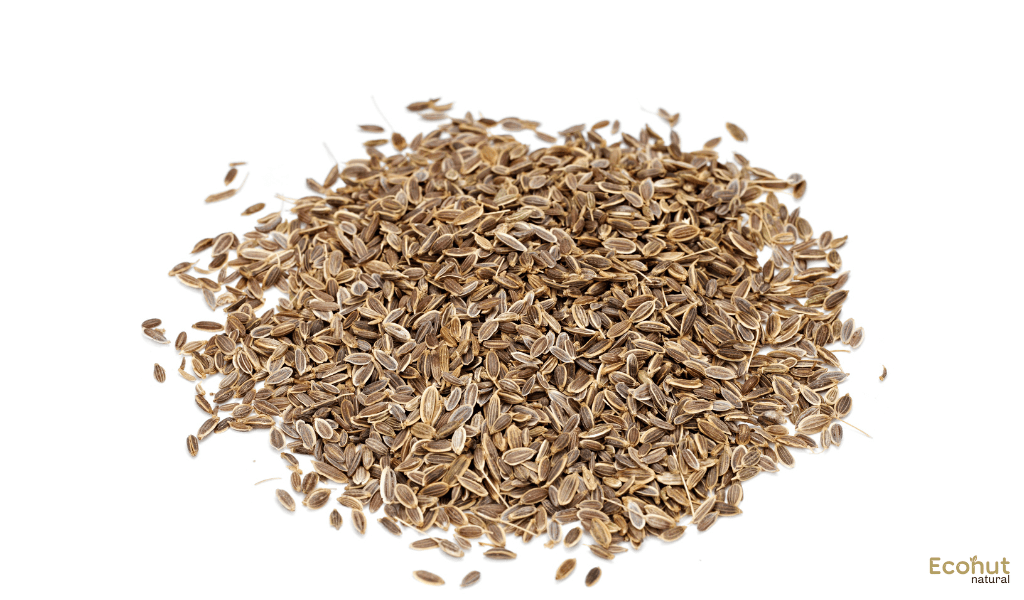Dill (Anethumn Sowa) is a very important and effective plant that has been utilized in Ayurveda for thousands of years. Leaves are used to flavor soups and curries, and seeds are also used as spices. The plant has a variety of therapeutic qualities that enable it to treat a wide range of medical conditions.
Dill weeds can reach a height of 16 to 24 inches. The hollow, slender, finely split stems feature alternating, 3.9–7.9-inch-tall, extremely delicate leaves. The leaf divisions are wider than the fennel leaves, measuring 1-2 mm in width.
Description
The dill plant has a slender, glabrous stem and grows to a height of around 90 cm. Dark green, alternate leaves are finely split into three to four pinnate segments.
Botanical Name:
Anethumn Sowa
Family:
Apiaceae
Leaves:
The plant appears delicate due to its feathery and delicately split leaves.
Flowers:
Umbels, or clusters of small, flat yellow blooms, are produced by dill. These clusters, which resemble miniature umbrellas, usually develop at the apex of the stems around midsummer.
Seeds:
Oval-shaped, flat, brown, 4-5 millimeter-long fruits (seeds) are produced by the blooms after they have withered. Dill seeds taste and smell strongly of citrus.
Stems:
Thin, hollow, smooth, and colored purple or greenish-grey
Habitat:
The dill plant is primarily indigenous to Mediterranean and southwest Asian regions. Nowadays, it is grown all over the world for its traditional and therapeutic uses. Northern and eastern European nations also cultivate it.
Parts Used:
- Fruits
Dosage:
- Fruit powder – 2-4gms
- Pure extract – 15-30ml
- Oil – 2-3 drops
Chemical Constituents
While Anethum graveolens is rich in carvone, Anethum sowa is rich in apiol. Dill ether (anethofuran), limonene, and α-phellandrene are the main ingredients in dill herb oil’s characteristic flavor.
Other Language Names of Dill (Anethumn Sowa)
Bengali name – Suva
Punjabi name – Soya
English name – Garden Dill, Dilly, Dill Weed, Indian Dill Fr
Marathi name – Shepa, Shipu
Urdu name – Shibt, Soya
Gujarati name – Suva
Russian name – Yukrop
German name – Gurkenkraut
French name – Aneth Odourent
Farsi name – Shebet
Tamil name – Satakuppa
Telugu name – Sadapa
Hindi name – Soya, Sova
Sanskrit name – Shatpushpa
Kannada name – Sabasige
Scientific Classification
| Kingdom | Plantae |
| Phylum | Magnoliophyta |
| Class | Magnoliopsida |
| Order | Apiales |
| Family | Apiaceae |
| Genus | Anethum |
| Species | Anethum graveolens |
Ayurvedic Properties
Rasa (taste) – Katu (pungent), Tikta (bitter)
Guna (qualities) – Laghu (light to digest), Teekshna (piercing, enters deep tissues)
Vipaka – (taste conversion after digestion)
Veerya (potency) – Balance Vata ad Kapha. lt increases pitta
Pharmacological action – Aromatic, stimulant, Carminative
Dill (Anethumn Sowa) Uses
- After birth, it can also be used to address hiccups, bloating, abdominal distention, and other issues.
- Additionally, it is utilized to lessen distention of the abdomen and flatus.
- Additionally, seeds are a great way to boost a weak appetite.
- Dill is an herb that helps with dysuria and renal colic. It helps with other urinary tract issues as well.
- Soaa seeds are helpful in decreasing elevated blood glucose levels and in lowering high cholesterol levels.
- For the treatment of asthma and cough, leaf powder is helpful.
Dill (Anethumn Sowa) Benefits
Diabetes:
Dill is effective in decreasing serum lipid and insulin level fluctuations in diabetic situations brought on by corticosteroids. This aids in managing diabetic problems. Therefore, eating dill is a nutritious and healthful strategy to lower your blood sugar levels.
Maintain Bone Health:
Because dill contains a high concentration of calcium, it provides the body with enough calcium to help shield the bones from losing mineral density and from bone loss.
Promotes Digestion:
Dill leaves are not only a powerful appetizer, but they also have excellent digestive properties. Fresh dill sprigs have an anti-flatulent quality that lessens gas production in the alimentary canal, which lessens bloating, flatulence, and distension of the abdomen.
Immunity Booster:
Dill is an effective antimicrobial. Thus, adding this herb to food will aid in lowering the body’s overall count of microbial illnesses. Additionally, it will prevent tiny cuts and open wounds from becoming infected.
Improve Respiratory Health:
The chemical called kaempferol found in dill may be the cause of the improvement in respiratory health. Furthermore, studies have indicated that it makes breathing easier and helps to eliminate mucus from the lungs and nasal cavities.
Diarrhea:
The two main causes of diarrhea are dyspepsia and microbial activity. The digestive qualities of dill lessen the likelihood of loose stools. Additionally, by destroying bacteria and germs, the monoterpenes and flavonoids in its essential oils also aid in the reduction of diarrhea. Dill consumption helps treat diarrhea as well as prevent it.
Dill (Anethumn Sowa) Side Effects
Allergic reactions:
Dill may occasionally result in allergic responses. Itching, vomiting, diarrhea, swelling in the tongue and throat, and trouble breathing are some of the possible symptoms.
Skin irritation:
Sometimes, applying dill topically can irritate the skin. Additionally, the skin may become more susceptible to sunburn due to the presence of fresh dill juice.
Read Also: Shatavari (Asparagus racemosus) – Uses, Benefits, Dosage & Side Effects
Conclusion
Dill leaves, full of vital nutrients and amazing medicinal qualities, are a perfect cure for a wide range of ailments. Dill leaves provide numerous health benefits, including improved bone health, infection prevention, respiratory abnormalities treatment, and improved digestion. So incorporate this fresh herb into your diet to reap its benefits without any negative consequences.
FAQS
What isDill (Anethumn Sowa) used for?
Anethum sowa L. is used in traditional medicine in several parts as an antioxidant, antibacterial, and antispasmodic agent as well as a carminative for the treatment of infantile colic, hiccups, and flatulence.
What is the benefit of Anethumn Sowa?
They can relieve flatulence, bloating, and indigestion. It’s frequently used to prepare teas or herbal treatments for digestive problems. Antispasmodic: Anethum sowa is helpful in reducing stomach cramps and spasms by relaxing the smooth muscles of the digestive tract.
Does dill have side effects?
Those who are allergic to dill may have skin discomfort. Furthermore, fresh dill juice may make skin more susceptible to sunburn. You may be more susceptible to skin cancer and sunburns as a result. Steer clear of the sun.

